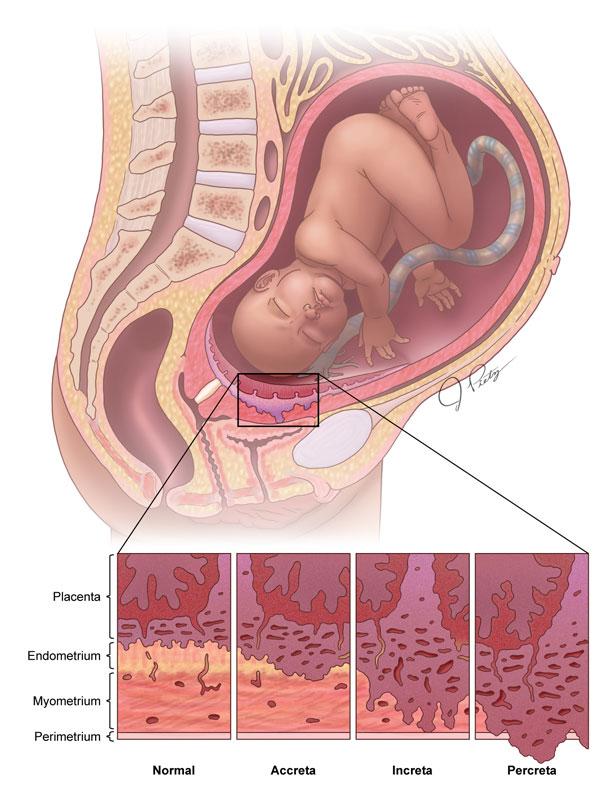Topics
Placenta accreta spectrum is a potentially life-threatening pregnancy complication that occurs in approximately 1 in 1000 to 2000 pregnancies. It occurs when the placenta grows too deeply into the wall of the uterus and is unable to detach at childbirth.
Women with this condition face complex pregnancies and deliveries. Risks to mother and baby include:
- Second or third trimester bleeding
- Excessive blood loss at delivery
- Premature delivery
- Need for a hysterectomy
Understanding the Condition
When you become pregnant, an organ known as the placenta (sometimes called the “afterbirth”) develops in your uterus. It attaches itself to the uterine wall and begins nourishing your growing fetus via the umbilical cord. Normally, the placenta detaches from the uterus after the birth of the baby.
In some women, the placenta grows too deeply into the uterine wall and becomes inseparable from the uterus. It is unable to completely detach and be expelled from the body and can lead to massive, possibly life-threatening hemorrhage in the mother.
Types of Placenta Accreta Spectrum
Placenta accreta spectrum is also referred to as “placenta accreta,” “placenta increta” or “placenta percreta” depending on how deeply the placenta is attached. All or part of the placenta may grow into the uterus, and different depths of invasion may be found in one placenta.

- Placenta accreta – the placenta grows into the uterine lining
- Placenta increta – the placenta grows into the muscular wall of the uterus
- Placenta percreta – the placenta grows through the wall of the uterus and in some cases into adjacent organs, such as the bladder, colon, or nearby vessels
Are You at Risk?
Not all women with risk factors develop placenta accreta spectrum, but the following are known factors that increase the risk of placenta accreta spectrum:
- Placenta previa, a condition in which the placenta covers part or all of your cervix
- Previous cesarean deliveries
- Prior uterine surgery, including removal of uterine fibroids or a dilation and curettage (D&C)
- In vitro fertilization (IVF)
- Advanced maternal age (35 years or older)
- Smoking
- Uterine conditions that cause abnormalities in the lining of the uterus, such as fibroids
The risk is greatest for women who have both placenta previa and a history of cesarean deliveries. The greater the number of cesarean deliveries a woman has had, the greater her risk.
Early Detection Can Save Your Life
Women with placenta accreta spectrum typically have no symptoms. In some cases bleeding may occur in the second or third trimester. Some women report pain that is much greater than expected in normal pregnancy.
With early diagnosis, lifesaving plans can be put in place to minimize the risks to you and your baby throughout your pregnancy and delivery.
Diagnosis is usually made through ultrasound imaging. The ultrasound testing can evaluate the location of the placenta and look for signs of abnormal growth into the uterine wall.
What to Look for in Treatment Options
The severity of these high-risk pregnancies makes it vitally important to seek the right care for you and your baby.
Your treatment should include:
- A multidisciplinary medical and surgical team experienced in managing these pregnancies and deliveries
- An established Placenta Accreta Spectrum program with standardized protocols and proven outcomes
- Delivery at a state-of-the-art facility with access to critical support resources, including 24/7 blood bank and transfusion services
- A carefully timed, well planned cesarean delivery that minimizes the risks of blood loss
- A contingency plan for emergency delivery
- Prenatal care that proactively addresses the risks to you and your baby, such as anemia treatment prior to any expected blood loss and steroids to promote lung function in preterm babies
- Immediate access to a high quality neonatal intensive care unit (NICU) after birth